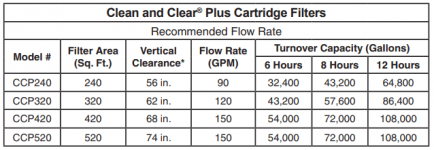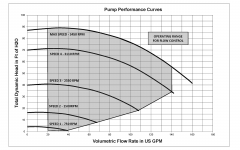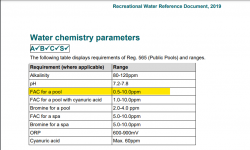- Feb 16, 2021
- 48
- Pool Size
- 13400
- Surface
- Vinyl
- Chlorine
- Salt Water Generator
- SWG Type
- Pentair Intellichlor IC-40
Thanks everyone for your thoughts  I definitely will do things differently this fall!
I definitely will do things differently this fall!
Sorry I missed this reply, thanks for the info, that possibility didn't occur to me.Just an observation...each of the cartridges shows damage in the same location, probably where the manifold was resting.
I was searching for thread from last year in which the OP had alternated between two sets of cartridges but only one set showed damage. I believe the OP contacted Pentair for a warranty claim. I can't find the thread now.
A couple other similar posts:
Pentair filter cartridge end cap deterioration
The blue end caps of my pentair cartridge filters are deteriorating. When cleaning them today, I noticed the rubber is very brittle as well. Pool and filters are 8 months old. Salt water. Is this normal?www.troublefreepool.com
Pentair Clean & Clear Plus 420 filter element lifetime?
So I had my pool installed last year, and started up in May. I ran the pool all summer with great water chemistry (thanks). I had the pool builder close to maintain warranty for the ridiculous price of $400 CAD (around $320 USD). I'll be opening the pool myself. So I opened up my filter and...www.troublefreepool.com
The pump manual is irrelevant to the filter issue.Talked to Pentair.. no warranty because on Page 2 of the IntelliFlo pump installation manual.. it states..
NO 90 degree piping used for inlet .. OR outlet.. Which my picture shows..
Was installed by another company not PB .( I'm not sure if Ontario code is the same ) .. I'll look into it thoughBy the way … did you install that gas heater or did the PB?
Just an FYI, it is NOT code to use those flexible yellow gas lines to supply the heater. Not only in the small diameter very restrictive but those flexi lines are NOT RATED for outdoor use. The gas supply should be hard galvanized pipe all the way to the gas valve inside the heater with proper unions and shutoffs. What you have their would fail inspection.
Pentair argument was that because the hard 90 - it increased pressure inside filter.. ( I would think it would increase it at the pump side.. though )The pump manual is irrelevant to the filter issue.
If the problem was with the pump, then maybe they could claim improper installation, but the problem is with the filter which means that the filter installation manual is what matters.
Even if the pump had an issue, they would have to prove or at least explain why the 90s caused a problem.
In any case, the filter was installed correctly and the warranty would still apply.
I worked with a propane guy as a side job about 7 years ago. We installed a bunch of pool heaters that summer using the above line for short runs and the 1 inch gas line version of pex, buried for long runs. The buried poly pipe used sharkbite like connectors if it was longer than the 100ft roll. They were massive, the size of a nerf football, but the same style push till it clicks like the 1/2 inchers.The gas supply should be hard galvanized pipe all the way to the gas valve inside the heater
Complete nonsense and irrelevant.Pentair argument was that because the hard 90 - it increased pressure inside filter.
Never Exceed Maximum Pressure of Components. The maximum working pressure of this filter is 50 psi.
Never subject this filter to higher pressure, even when conducting hydrostatic pressure tests.
Pressures above 50 psi can damage your filter


Just a follow up .. because I thought the install was bad as well..By the way … did you install that gas heater or did the PB?
Just an FYI, it is NOT code to use those flexible yellow gas lines to supply the heater. Not only in the small diameter very restrictive but those flexi lines are NOT RATED for outdoor use. The gas supply should be hard galvanized pipe all the way to the gas valve inside the heater with proper unions and shutoffs. What you have their would fail inspection.
When abandoning the buried heating oil tank for an above ground in order to sell my house, we used the same flex pipe, just, the orange one instead of the yellow.a) Outdoors – When installed outdoors, the external jacketing shall remain intact as much as practical for the given installation
When abandoning the buried heating oil tank for an above ground in order to sell my house, we used the same flex pipe, just, the orange one instead of the yellow.
Now that Matt points it out, it probably doesn't fare so well 100 miles south of Heck.
honestly .. i still didn't like it, but with no code issues.. I can't really force the issue without paying more..TRUTH!!
Yeah, there’s no way you can use that jacketed flexible stuff outdoors anywhere here. It would be vaporized in under a year. Gas lines are either either thick-walled PEX (buried, low pressure) or galvanized iron (above ground, high pressure). Transition from below ground with a riser is all galvanized pipe to the heater. No flex allowed.
I can understand the Canadian code being more lenient …
I believe in TPF method.. the question is.. what do i say to them.. lol.You chems are fine. They’re going to say your FC was out of spec, too high. They base their FC on industry standards, 1-4ppm with no correction for CYA. They’ll probably also say your pH was too high … expect them to continue to balk.
Ontario Regulation 565 - Public Pools (Reg. 565 (Public Pools)) under the Health Protection and Promotion Act R.S.O 1990 (HPPA) was modernized to include regulatory requirements for public pools, public spas and Class C facilities (wading pools, spray pads, splash pads and water slide receiving basins).
The Recreational Water Reference Document (RW-RD), represents generally accepted practices for the safe operation of a public recreational water facility and includes summary information about Reg. 565 (Public Pools).
Flow Rate: Commercial rate is a maximum of .375 GPM sq. ft. of filter area.


